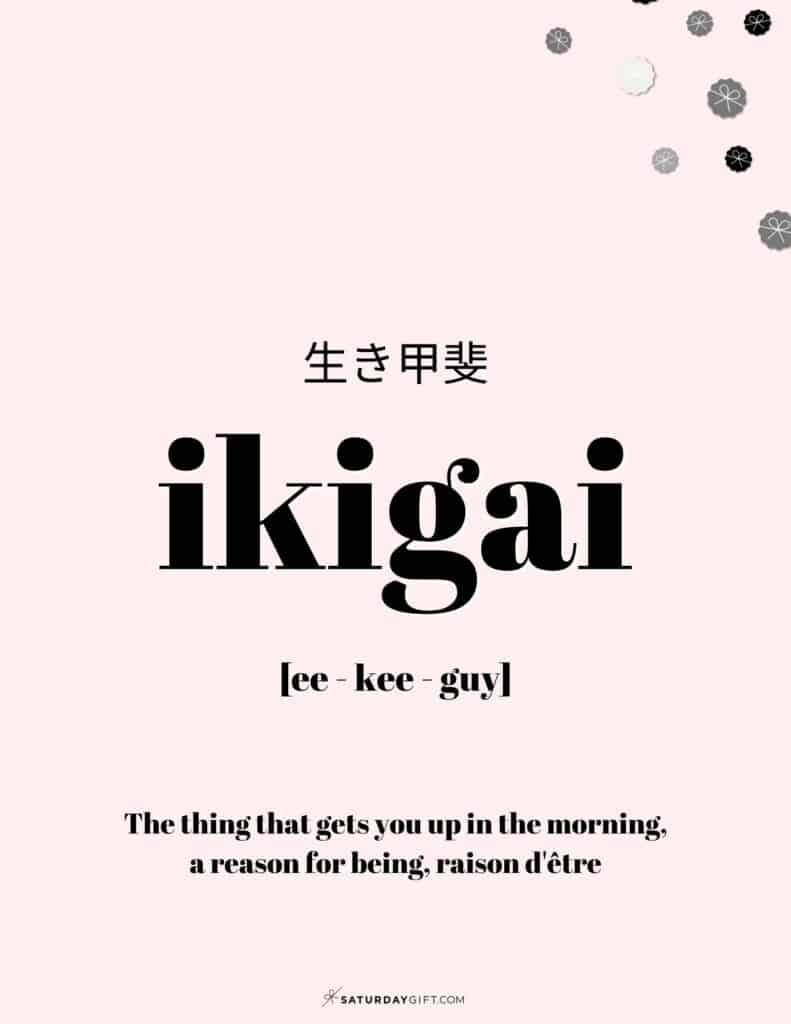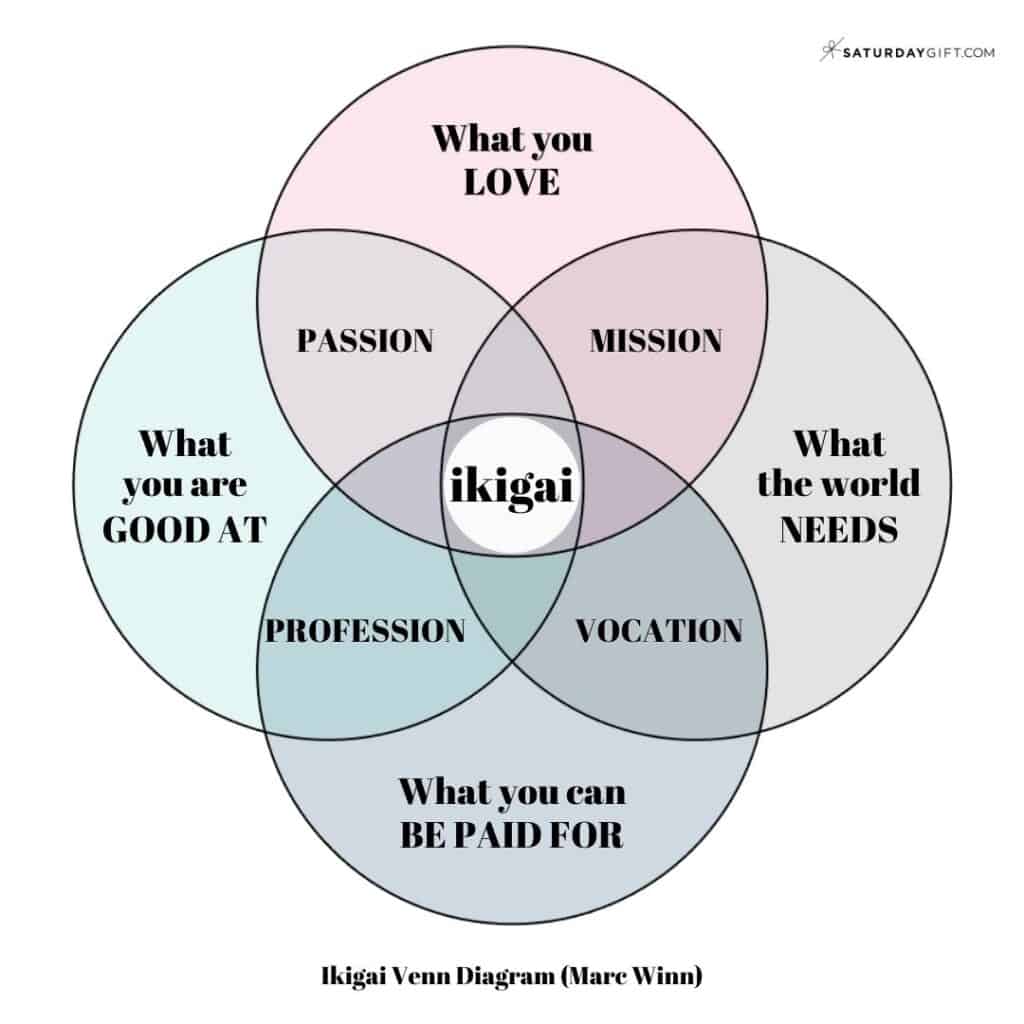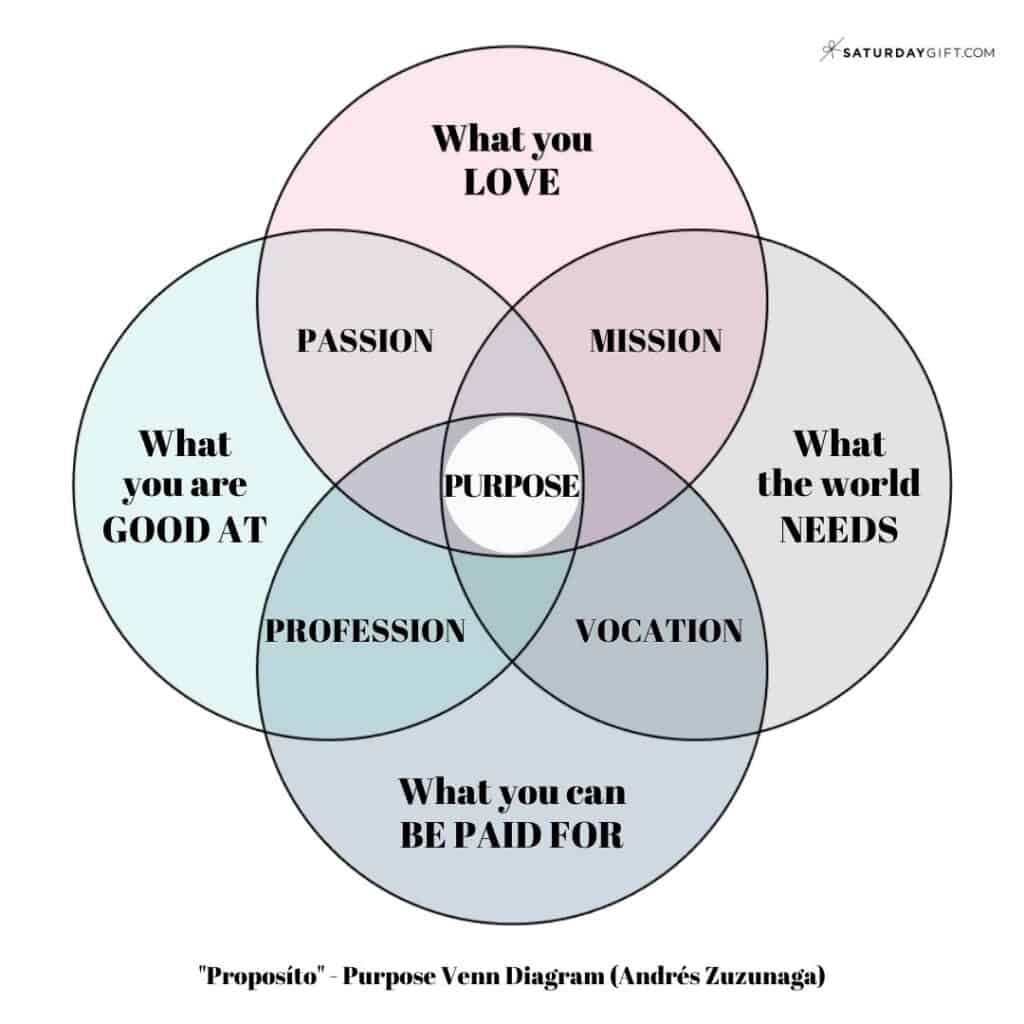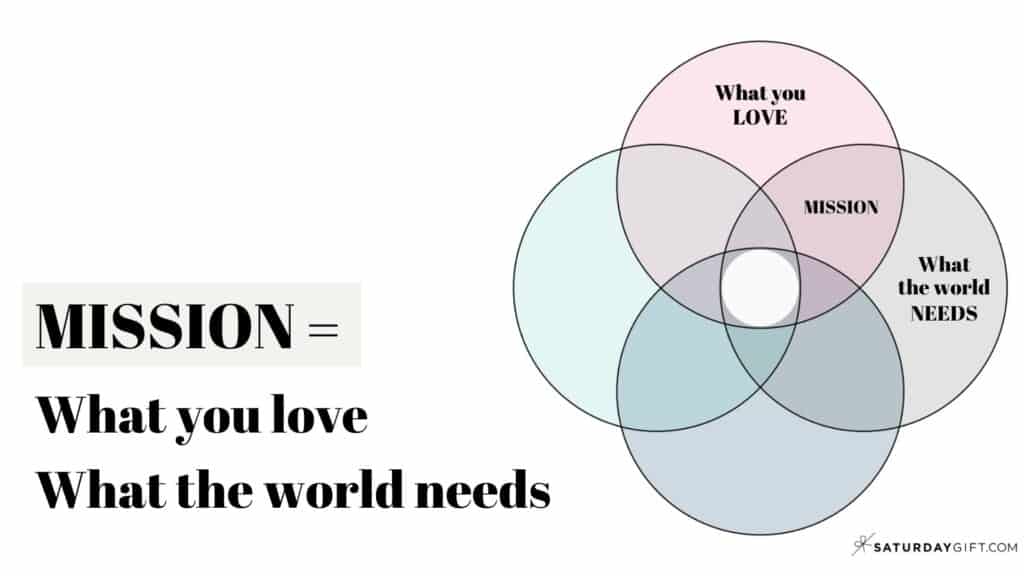Find Your Ikigai – The Ultimate Guide to Find Meaning in Everyday Life
This post may contain affiliate links, which means I’ll receive a commission if you purchase through my links, at no extra cost to you. Please read full disclosure for more information.
What’s the reason you wake up in the morning? Here’s everything you need to know about ikigai and how to start a journey to find meaning in everyday life.
Ikigai is a Japanese word that means “a reason for being” or “
We all have one, but how do we find it? Or maybe you’ve already found your ikigai.
- Are you doing something you love?
- Is that also something you’re good at?
- Is it something you get paid for?
- And is it something the world needs?
If you answered ‘yes’ to all those questions, then congratulations! You’ve found your ikigai. At least according to the ikigai diagram.
But ikigai is much more than that. So let’s dig deeper into the Japanese concept called: ikigai.

- What is the Japanese concept of ikigai?
- But how do you pronounce it? How do you pronounce Ikigai?
- The five pillars of ikigai
- Ikigai diagram (by Marc Winn)
- The 4 elements of Ikigai – according to the ikigai diagram.
- How can you find your ikigai?
- What if you can't combine all 4 elements of the ikigai diagram
- What are the benefits of the Japanese concept of ikigai?
- What does it mean to live "ikigai life"?
- The ten rules of Ikigai
- Books and TED talks about ikigai.
What is the Japanese concept of ikigai?

Ikigai is a Japanese concept – a philosophy – that is difficult to describe in just one word or sentence.
It has been described as the state of having a deep sense of
The word ikigai – is a combination of the Japanese words iki and gai. ‘Iki’ meaning ‘life,’ and ‘gai’ meaning ‘worth’ or ‘value.’
A person’s ikigai reflects what they find satisfying, meaningful, or essential to them.
Loosely translated in English, it means “the reason for which one lives,” ”
Or it can be defined as “the thing that makes you get up in the morning.”
- It’s the core drive behind what motivates us, and it tends to lead to greater happiness, satisfaction, and fulfillment.
- It’s the thing that motivates you to get up in the morning and enjoy what you do.
Héctor García and Francesc Miralles call their book Ikigai: the Japanese secret to a long and happy life. And that name pretty well sums it up.
People with ikigai are generally happier, healthier, more satisfied people than those without ikigai. They tend to have a sense of
It has been said that ikigai is the closest thing to a one-word definition of happiness.
But how do you pronounce it? How do you pronounce Ikigai?
The pronunciation of the word ikigai is ee-kee-guy.
I keep saying it ick-ee-guy like “icky guy,” but I think that’s wrong. It’s just so much easier to remember the name of the concept that way 😀
You can listen to the pronunciation here

The five pillars of ikigai
According to Ken Mogi, the author of the book Awakening Your Ikigai: How the Japanese Wake Up to Joy and Purpose Every Day, there are five pillars of ikigai:
- Starting small
- Releasing yourself
- Harmony and sustainability
- The joy of little things
- Being in the here and now
Ken Mogi emphasizes that these pillars are essential and “allow ikigai to flourish.” So keep them in mind whenever you’re thinking about your ikigai or your life
Check out the book:
And this is my interpretation of those pillars:
Pillar #1: Starting small
What does it mean to start small?
To start small can mean to think about the present moment, one step at a time. To partake in activities and put your whole effort into them. You’ll find that success will come in due time by doing this.
The key to starting small is to focus on what you can do now instead of waiting for the “big” change that will magically make your situation better. This can be applied to everything we do.
Pillar #2: Releasing yourself
What does it mean to release yourself?
Releasing yourself can mean freeing yourself from fears, guilt, external expectations, ego, and responsibilities, pretty much anything that is no longer serving you.
It means trusting your intuition to guide you in the right direction.
What doesn’t it mean to release yourself?
- It doesn’t mean letting go of responsibilities or forgetting relationships.
- It doesn’t mean being irresponsible or neglecting to honor your commitments.
- It is not about neglecting the welfare of others because you are engrossed in an activity.
To release yourself means to make for ourselves a good spiritual life and pursue our personal goals, all with consideration for the needs of others and mindful attention to our environment.
The idea of releasing yourself is that you are not letting go. You’re freeing up energy and time so that you can make better decisions about what’s important at the moment without feeling burdened by past mistakes or future expectations.
Pillar #3: Harmony and sustainability
What do harmony and sustainability mean in everyday life?
Harmony and sustainability are crucial when it comes to leading a happy life.
It’s the ability to find balance in every aspect of your life – social, mental, emotional, and even physical. Simply put, finding harmony means finding the cohesion that brings healthy existence between self and others (and the environment).
It means that things are working together, and there is balance.
Pillar #4: The joy of little things
What does the joy of little things mean?
Deep joy comes from inside, and it shouldn’t be dependent on something outside of ourselves.
To find joy, we need to listen to our inner voice and find deep-seated reasons for feeling happy.
The joy in little things is the rediscovery and appreciation for all we have – our loved ones, work, health, shelter, etc. It’s about being grateful for what you currently have instead of focusing on what will make your life more complete in the future.
And there are so many little things to enjoy in life!
Psst! I have this mantra that helps me remember to enjoy the little things: Find happiness in the ordinary, and your life becomes extraordinary.
Pillar #5: Being in the here and now
What does being in the here and now mean?
When you’re in the here and now, you are fully present in your life. You have one hundred percent of your attention focused on what is happening right at this moment.
Being in the here and now means to live purposefully. And with
And now that we’ve covered the 5 pillars of Ikigai, we can move on to the ikigai diagram.
Ikigai diagram (by Marc Winn)

You might have bumped into the ikigai diagram before.
You know, the four circles stating things you love, are good at, what the world needs, and you can get paid for, and when they intersect, you can find your passion, vision, vocation, and profession.
And if all those intersect, you have found your ikigai.
Originally this diagram was made by Andrés Zuzunaga, and it was precisely the same – only the center word didn’t say ikigai, but
And then Marc Winn wrote a blog post, added an image where he changed the center word to ikigai, and the westernized concept of ikigai was born.
In Marc’s own words, “The sum total of my effort was that I changed one word on a diagram and shared a ‘new’ meme with the world.”
Here’s the “Proposíto” Venn diagram about

And here’s the Ikigai Venn diagram by Marc Winn.

Ikigai is so complex, so this kind of simple visualization allows it to be understood by all of us much faster.
So how can this visualization tool help you find your ikigai? Let’s dive right into it next.
Note: There’s a bit of controversy about the ikigai diagram. The diagram is more of a western interpretation of the Japanese concept of ikigai. But in this post, I’ll go through it as a tool to find your Ikigai.
The 4 elements of Ikigai – according to the ikigai diagram.

The ikigai diagram holds four main elements in it:
- What you love
- What the world needs
- What you are good at
- What you can get paid for
And in the intersections of two of the elements, you’ll find
- Your passion
- Your mission
- Your Vocation
- Your Profession
In other words, the key elements to find your
- Your passion = what you love and what you’re good at
- Your mission = what you love and what the world needs
- Your vocation = what you can be paid for and what the world needs
- Your profession = what you are good at and what you can get paid for
And when all those four elements (what you love, what you are good at, what the world needs, and what you can be paid for) come together, you have found your ikigai.





How can you find your ikigai?
There are many ways in which ikigai can be found. I’ll give two simple exercises you can try out.
Find your ikigai exercise #1
One way is to start writing down the things (1) you love and see whether you’re (2) good at doing them and if they’re something (3) the world needs, and (4) you could get paid for.
If you have difficulties finding out what you love and what your passions are, you can start the search for your life’s mission, for example, by answering these questions:
- If you could do only one thing, what would that one thing be you want to do with your life?
- What are the things that light you up and make you come alive?
- What are the things that when you do them the time flies?
- What kind of work doesn’t feel like work?
- What’s your passion? What subjects or concepts are you passionate about?
- What are the things that you love doing more than anything else?
Chances are, these might also be skills or abilities that are needed in the world.
Find your ikigai exercise #2
The other way to find your ikigai is to do this exercise in reverse: think of things the (3) world needs and (4) you could get paid for.
Are they something you (1) love to do and are (2) good at doing? Or are they something you could become good at doing?
Think about what makes you feel fulfilled, valued, and excited.
Fulfillment means anything from feeling like you matter in society to having a
For some people, this might mean spending time caring for others. For others, ikigai might be to create a wonderful piece of art.
The world is always in need of people who are passionate about what they’re good at. And if it’s needed, then most likely, you’ll find ways to get paid for it.
RELATED POST: Life Purpose – 10-step Framework to Discover Your True Purpose
What if you can’t combine all 4 elements of the ikigai diagram
The four elements of Ikigai are interconnected, and when you discover your ikigai, the benefits will show themselves in all areas of life.
Ikigai is about finding a way to live your everyday life meaningfully.
The four elements of ikigai can work together to provide a sense of satisfaction. But if you don’t have all those four elements in place, it might be hard to find peace and meaning in your life.
And if you have three of the four elements, you have many good things going on for you. But something is still lacking to feel totally satisfied:
1) Satisfaction, but feeling of uselessness
If you do
- what you love
- what you are good at
- and you can be paid for it
- but the world doesn’t need it
You might find satisfaction but might have a feeling of uselessness
2) Comfortable, but feeling of emptiness
If you do
- what you are good at
- and you can be paid for it
- and the world needs it
- but you don’t love what you do
You’ll be comfortable but might have a feeling of emptiness
3) Delighted and fullness, but no wealth
If you do
- what you love
- what you are good at
- and the world needs it
- but you can’t be paid for doing it (or at least not enough)
You’ll feel delighted and full but have no wealth
4) Excitement and complacency, but sense of uncertainty
If you do
- What you love
- And you can be paid for it
- And the world needs it
- But you’re not good at it
You might feel excitement and complacency, but you might have a sense of uncertainty.
Try to identify which part of the 4 elements is missing and work on it.

What are the benefits of the Japanese concept of ikigai?
The benefits of ikigai are numerous.
Don’t think about just finding your flow and a feeling of
With the focus on living a fulfilling and meaningful life, ikigai has been shown to contribute to life longevity. At least, according to Héctor García’s and Francesc Miralles’ book The Japanese Secret to a Long and Happy Life.
Like living with
- provide extra energy
- increase productivity in work and school
- relax your mind
- improve sleep quality
And it can make us more empathetic by increasing our capacity to understand what others need from us because ikigai is one of those things that happens when you’re in the zone.
And ikigai can help us to better understand who we are.
We may not be able to control what our ikigai is, but we can nurture it and allow it to grow.
In doing so, we are more likely to find happiness or fulfillment with life’s challenges.
Ikigai is not something that you find once, and then it’s forever “fixed.” It changes over time as our needs, desires, and dreams change in life.
However, ikigai provides us with a general direction for finding what we need to live happy lives.
What does it mean to live “ikigai life”?
Ikigai is a state of enjoyment. Happiness. It means to be content.
So what does it mean to live “ikigai life”?
To answer this question, we should first ask ourselves what makes us happy and fulfilled. Also, what are our long-term
In other words, when we figure out who we are and what meaning on ikigai is, we’ll know what our work should be.
Ikigai can be achieved in several ways, for example:
- through healthy practices and habits that allow us to live long lives with vitality
- by understanding the things we are good at and fulfilling those skills for others
- or by developing passions and hobbies that bring joy
Ikigai is a concept that represents the Japanese spirit of harmony and balance between one’s physical, mental, spiritual, social, and creative sides.
Learning to live an ikigai life is about choosing a lifestyle that allows you to enjoy your time, and it’s not something we need to figure out as soon as possible.
It might take years of finding the right ways for us individually – through trial-and-error or experimentation with different passions – but when we finally get there, it’s like the weight of the world has been lifted off our shoulders.
And to start living your ikigai life, who would be better to teach us, give us tips, and share their longevity secrets than the centenarians of Japan.
Want to define your personal core
The ten rules of Ikigai
Héctor García and Francesc Miralles, the authors of the book Ikigai The Japanese Secret of Long and Happy Life, interviewed Okinawa’s centenarians to understand and capture their longevity “secrets.” They combined what they learned into these ten rules of Ikigai:
- Stay active; don’t retire.
- Take it slow.
- Don’t fill your stomach.
- Surround yourself with good friends.
- Get in shape for your next birthday.
- Smile.
- Reconnect with nature.
- Give thanks.
- Live in the moment.
- Follow your ikigai.
Sound pretty awesome, balanced, and doable rules to live by, don’t they?
Check out the book:
Héctor García and Francesc Miralles
Ikigai can provide a sense of
It offers us direction in life by giving us goals to strive towards that satisfy immediate needs and long-term desires.
For some people, it’s a hobby or passion they can turn into their livelihood; for others, it might be the family that provides supportive love and care when life gets tough.
It doesn’t matter what your ikigai is as long as you’re living it and enjoying your fulfilling life.
Books and TED talks about ikigai.
Héctor García and Francesc Miralles
You might also like this TED talk by Dan Buettner – How To Live To Be 100+ (Start at 9:54 if you want to skip straight to the part about the Japanese concept of ikigai)
And this TED talk by Tim Tamashiro – How to Ikigai.
READ NEXT: Life Purpose – 10-step Framework to Discover Your True Purpose



